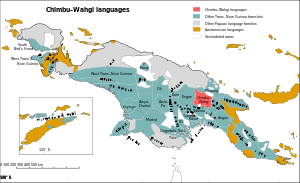Chimbu–Wahgi languages
The Chimbu–Wahgi languages are a language family sometimes included in the Trans–New Guinea proposal.
| Chimbu–Wahgi | |
|---|---|
| Central East New Guinea Highlands Simbu – Western Highlands | |
| Geographic distribution | Papua New Guinea |
| Linguistic classification | Northeast New Guinea and/or Trans–New Guinea?
|
| Subdivisions |
|
| Glottolog | cent2120[1] |
 Map: The Chimbu–Wahgi languages of New Guinea
Chimbu–Wahgi languages
Trans–New Guinea languages
Other Papuan languages
Austronesian languages
Uninhabited | |
Languages
There is little doubt that the Chimbu–Wahgi family is valid. The languages are:[2]
- Chimbu–Wahgi family
- Chimbu (Simbu) branch
- Western Highlands
- Jimi River
- Wahgi Valley
- Nii, Wahgi, North Wahgi (= Yu We?)
- Mount Hagen
- Melpa (Medlpa)
- Kaugel River: Imbo Ungu, Umbu-Ungu, Mbo-Ung (Bo-Ung)
Phonology
Several of the Chimbu–Wahgi languages have uncommon lateral consonants: see Nii, Wahgi, and Kuman for examples.
Chimbu–Wahgi languages have contrastive tone.[3]
Pronouns
The singular pronouns are:
sg 1 *ná 2 *nim 3 *[y]é
Dual *-l and plural *-n reflect Trans–New Guinea forms.
Evolution
Middle Wahgi reflexes of proto-Trans-New Guinea (pTNG) etyma:[3]
- ama ‘mother’ < *am(a,i)
- amu ‘breast’ < *amu
- numan ‘louse’ < *niman
- numan ‘thought, mind, will’ < *n(o,u)
- man, muŋ ‘fruit, nut, lump’
- muŋgum ‘kidney’ < *maŋgV ‘round object’
- mundmuŋ ‘heart’ < *mundun-maŋgV
- mokum, mokem ‘knuckle, joint’ < *mo(k,ŋg)Vm ‘joint’
- mundun mo- ‘be pot bellied’ < *mundun ‘internal organs, belly’
- ŋaŋ ‘small male child’ < *ŋaŋ[a] ‘baby’
- apa- ‘maternal uncle’ < *apa ‘father’
- embe(m) ‘name’ < *imbi ‘name’
- muk ‘blue’ < *muk
- tuk- ‘chop’ < *tVk- ‘cut, cut off’
- no- ‘eat’ < *na-
- mek si- ‘to vomit’
- mek ‘vomitus’ < *makV[C] + t(e,i)- ‘to vomit’
gollark: No.
gollark: Fun fact: my unlicensed hovercraft pub is technically legal.
gollark: It's possible that it's invoking a few dark rituals to do so, but you know.
gollark: My phone's music player app is highly advanced™ and also capable of categorizing by tag autonomously.
gollark: Ah yes, seedling?
References
- Hammarström, Harald; Forkel, Robert; Haspelmath, Martin, eds. (2017). "Chimbu-Wahgi". Glottolog 3.0. Jena, Germany: Max Planck Institute for the Science of Human History.
- Usher, Timothy. Simbu-Western Highlands. New Guinea World.
- Pawley, Andrew; Hammarström, Harald (2018). "The Trans New Guinea family". In Palmer, Bill (ed.). The Languages and Linguistics of the New Guinea Area: A Comprehensive Guide. The World of Linguistics. 4. Berlin: De Gruyter Mouton. pp. 21–196. ISBN 978-3-11-028642-7.
Further reading
- Ross, Malcolm (2005). "Pronouns as a preliminary diagnostic for grouping Papuan languages". In Andrew Pawley; Robert Attenborough; Robin Hide; Jack Golson (eds.). Papuan pasts: cultural, linguistic and biological histories of Papuan-speaking peoples. Canberra: Pacific Linguistics. pp. 15–66. ISBN 0858835622. OCLC 67292782.
- Ross, Malcolm. 2014. Proto-Chimbu-Wahgi. TransNewGuinea.org.
External links
- Kaipuleohone archive of Chimbu-Wahgi language recordings
This article is issued from Wikipedia. The text is licensed under Creative Commons - Attribution - Sharealike. Additional terms may apply for the media files.